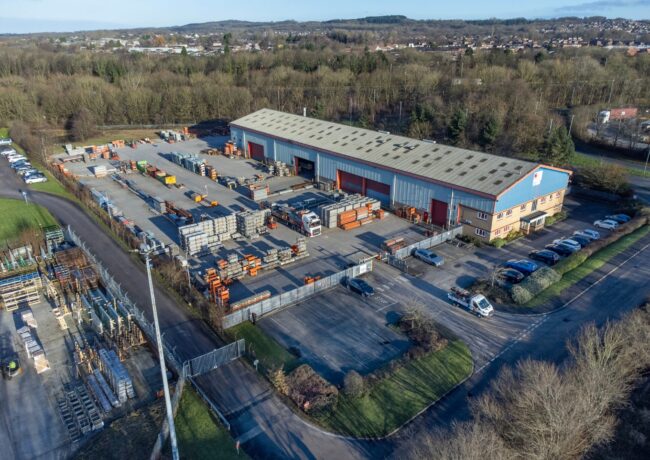The Subplot
The Subplot | Boris gets a warning, important numbers, shed mysteries
Welcome to The Subplot, your regular slice of commentary on the North West business and property market from Place North West.
THIS WEEK
- Boris, please listen: M&G Real Estate plans a £300m Manchester investment, and hopes the government is paying attention
- Wall of money: still there, and growing despite everything
- Shed mystery: do we have a solution?

YOU HAVE BEEN WARNED
Massive investment pending, if Boris gets it right
M&G Real Estate wants to step up its already substantial North West portfolio, and has its eye on a £300m plus mixed regeneration project and more office development.
But in the wake of the apparent death of Northern Powerhouse Rail, and anxieties about the imminent Levelling Up white paper, is government undermining the rationale for investment?
Last week’s Integrated Rail Plan announcement and the soon-to-land Levelling Up white paper have spooked and unsettled the property market. No investor is more seriously committed than M&G Real Estate whose portfolio includes a half share of the Manchester Arndale Centre, the recently completed 102,000 sq ft Lincoln office scheme, The Peel Centre in Blackburn, and Gemini Retail Park in Warrington. Is M&G confident? Does the direction of public policy set alarm bells ringing? Chris Perkins, M&G Real Estate’s head of UK capital markets, spoke exclusively to Subplot.
A £300m investment
You can take it for granted that M&G is confident. Last week it revealed plans to demolish 50 Fountain Street, Manchester, and replace it with a new 55,000 sq ft development. That’s just the start, says Perkins. “We very much want to invest further capital in Manchester, via upgrades of existing assets like 50 Fountain Street, but also we’re looking for opportunities for place-making at scale, as we have been in other cities. We’d like to take more development risk on office schemes and think our exposure to Manchester will grow significantly,” he says.
Development at scale
What Perkins has in mind is something like the Edinburgh Haymarket development or, put it another way, an expansion of what M&G did (with others) at 101 Embankment. “We’re talking multiple hundreds of millions. Haymarket Edinburgh was £300m plus in value and if we could replicate that sort of opportunity with mixed use in a key area, it has appeal. We are actively looking for opportunities,” he says. The difficulty is that sites are scarce, and a couple of the best joint venture opportunities (Mayfield, Media City) have just been snapped up by Land Securities (Subplot, 9 November).
But where?
But the hunt is in progress, a swift outcome (think something promising within 12 months) is anticipated so the team has a smooth workflow through The Lincoln, onto 50 Fountain Street in 2023/4, and beyond. Early days but maybe this will involve unknotting the kind of tangled site only somebody with M&G’s connections and skills could manage.
Active asset management
In the meantime, the focus on letting The Lincoln (tails are up on pre-lets) and keeping the Arndale fresh (no hint that M&G plans to offload their part-ownership). Perkins neatly sidestepped a question about the future of M&G’s Warrington and Blackburn assets, so draw your own conclusion.
But the government
So what could screw up this happy feeling? The answer is the government. Perkins says M&G is supremely comfortable with its North West portfolio, and it is government attitudes that helps keep them comfortable. “If Manchester didn’t have the support from government, and devolved powers, and central government investment, we’d have been more cautious,” says Perkins. “If Greater Manchester didn’t have a mayor, and joined-up thinking on planning, and a sense of long-term vision, we’d be more cautious.”
The big question
As for Northern Powerhouse Rail, while Manchester got a slice of the new high speed line from Warrington to Huddersfield, and another from Crewe to Piccadilly, the project itself seems to be in trouble and the Leeds to Liverpool links everybody wanted are missing. Is that just irritating, or something worse, Subplot asked?
Get on with it
“If NPR didn’t happen that would be more than an irritant. We’d already been committed to the North without it, but the turbo-charging of investment going forward is greatly enhanced by HS2 and improved transpennine infrastructure,” says Perkins. “We want to ensure the initial concept of a Northern Powerhouse is brought to fruition, and that the levelling up agenda does not get derailed.” The language here is measured. M&G is not firing a shot across the government’s bows, but maybe it is placing an interesting marker for the future?
Big picture
The slight sense of impatience with government is reinforced elsewhere in the M&G empire. Last week the firm launched its latest Global Outlook report embracing such hot topics as inflation risk (not very worried) and ESG (very worried). Asked about the UK government’s rethinking of English regional policy in the Levelling Up white paper, head of investment strategy and research Jose Luis Pellicer said something interesting.
Money talks
“There are pledges and words, and then there’s action,” Pellicer said. “If we see proper infrastructure investment, social infrastructure, actual real money such as grants for research to universities, hard cash going into the region, then regional policy counts. If it is just words – or [gestures like] a new fountain – we can’t see that impact. Hard cash is good, infrastructure has a real effect, and without it a building is worthless. So it only counts when there is money behind it.”
That sounds a bit more like a warning, and if it is, it is one central government will be wise to heed.
DRIVING THE WEEK
 It ain’t over yet
It ain’t over yet
That “wall of money” you’ve been hearing about for the last ten years? It isn’t going away, and the tsunami’s third wave is already crashing over the North West.
Cornell University and Hodes Weill & Associates latest annual Institutional Real Estate Allocations Monitor has just been published. Dry stuff, you might think, but that couldn’t be more wrong. Their conversations with 224 institutional investors in 37 countries, who between them manage US$1.2tn, is very good news for the North West’s investment hot spots.
The Agatha Christie Rule
Investment, like murder, is about three things: you need the means, the motive and the opportunity. The Cornell/Hodes Weill data suggests investors have an abundance of all three.
Animal spirits
First, the motive. Cornell’s team found that confidence in real estate is sky high: investors haven’t been this bullish since 2012, the year the world began to pull out of the Great Financial Crash. It’s worth saying investors could be in the grip of bonkers group-think, and, given post-pandemic uncertainties, China’s pivot away from free trade, inflation and so much else, that’s Subplot’s view. But confidence is what the research found so we have to go with it, for now.
Hard money
Second, the means. They have the means because global allocations to real estate (as opposed to equities, gilts, and other fancy stuff) is relatively light. The average target allocation in 2021 is 10.7%, yet actual allocation ends the year much lower, perhaps as low as 9.3%, which is worse even than in 2020. As many as two-thirds of investors are under-allocated by about a fifth, and in the Asia-Pacific region by almost a third. In other words, they need to do a lot of investing in real estate to get anywhere near their target allocations. The Hodes Weill/Cornell people say this implies an extra $80-120bn allocated to real estate. That’s a lot of spending.
Who is that?
At this point, please meet a suspicious character called the Denominator Effect. The reason why investors are underweighted on property is because property values slipped in the last year or so, and, relatively, other asset classes did quite well (that relative movement is the Denominator Effect). So property being under-weighted is not a sign of how good property is, but how bad. Now you could say, and investors absolutely do, that this makes a brilliant moment to buy property at distressed or sub-expectation prices, and that there are bargains to be had in the retail and office sectors. All change is good, goes the cry and this is the third element in the investment triad – the opportunity. But it is also true that the collapse of an asset class shouldn’t really be a reason for unprecedented confidence.
Bargain hunters
Cornell/Hodes Weill point out that a lot of the projected investment is either bargain hunting, or cross-border (e.g. not on familiar home turf), and that investors have satisfied their appetite for risk in well-known geographies so may not need to look towards emerging markets. The North West is no longer an emerging market (see Subplot, 9 November) – which bodes well. As if to prove the point yesterday Schroder Real Estate Investment Trust bought three North West industrial assets for £19.85m, representing a nice fat net initial yield of 6.9%. These include the 190,000 sq ft Valley Road Industrial Estate in Birkenhead, the 98,551 sq ft Coral Products site at Haydock, and two slices of Newfield Fabrications site at Sandbach.
IN CASE YOU MISSED IT…
A mystery solved?
Was “safety in numbers” the reason for last year’s surprise decision to call-in five applications for up to 6.8m sq ft of much-needed warehousing?
The fate of five North West logistics schemes, totalling 6.8m sq ft, hung in the balance for most of the last twelve months. The government called in five applications in May 2020, a year after some schemes first won planning permission. This was frustrating for developers, and destabilising for a market where demand vastly exceeded supply. The effect was to slow job creation and nudge up rents, putting on hold an estimated £1.4bn worth of economic benefits as Subplot reported in January. Why would the government do such a thing, many in the shed market asked? “Politics” was a popular answer.
Hard to grasp
The mystery deepened as time went on. Four of the five schemes got waved through. The inspectors’ reports and ministerial decision letters revealed fairly minor grounds for concern, some of them technical in the narrowest, most exasperating sense of the word. Earlier this month the fourth out of five was approved: Langtree Developments’ plans for a 1m sq ft logistics scheme at Parkside Colliery, St Helens, got the green light. The approval, by Secretary of State Michael Gove, also unlocks the £38m link road from the 230-acre site to the M6 motorway.
Final reveal
Last week we got the final reveal, as ministers announced their decision on Peel L&P’s plans for its 1.8m sq ft Haydock Point scheme. Mr Gove agreed with a planning inspector that the Haydock Park site is protected Green Belt and that development would cause substantial harm. “The Secretary of State notes that there is no dispute between the parties that the proposed development would be inappropriate in its Green Belt location, giving rise to harm by definition,” a decision letter said. “He further agrees that the built development would encroach blatantly into the countryside of rural St Helens, in further contravention of the purposes of including land in the Green Belt.”
Clues, maybe
Remembering that Peel asked to be included in the big rethink, cynical observers have two options here. From the government’s point of view, if you know you’re going to have to knock back a developer with as much clout as Peel it helps to have some cover, and a wider look at regional Green Belt and four other schemes intruding onto it, provided this. From Peel’s point of view, bundling its site up with several others might have offered some trade-offs, or some of the fog of war, or guaranteed it four conscripted allies who also want a quick, positive decision. Whatever the reasoning, this trying episode is now over.
The Subplot is brought to you in association with Cratus and Oppidan Life.





